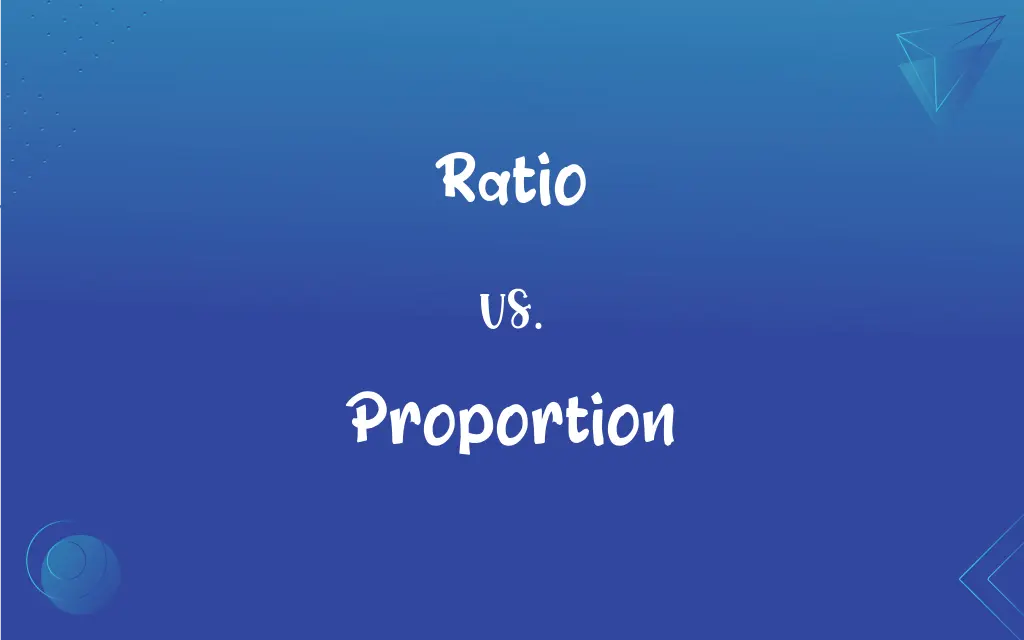Ratio vs. Proportion: What's the Difference?
Edited by Janet White || By Harlon Moss || Updated on October 10, 2023
A ratio expresses a relationship between two quantities, while a proportion is an equation stating that two ratios are equivalent. E.g., ratio: 4:5, proportion: 4/5 = 8/10.

Key Differences
Ratio, in its essence, represents a relationship between two numbers, indicating how many times one number is contained within the other. In contrast, a proportion is a statement that establishes the equality between two given ratios. For example, if we have a ratio of 4:5, it illustrates that the first number is 4 times some quantity, and the second number is 5 times that same quantity.
To delve deeper, a ratio is a simple comparison and can be written in several forms such as 3 to 4, 3:4, or 3/4. Proportion, on the other hand, involves two ratios and showcases a numerical equivalence. In other words, it illustrates that one ratio is the same as the other, such as 3/4 = 6/8, where the quantities change but the relationship remains constant.
Understanding ratio further, this concept finds applications across varied fields like mathematics, finance, and science, denoting relative sizes. The ratio is also prominent in everyday contexts like recipes in cooking. Proportion stands out when discussing the similarity of two distinct ratios. In science, particularly in creating solutions, maintaining proportion is essential to achieve the desired chemical balance.
In the realm of statistics, the term ratio is frequently used to compare sizes, occurrences, or changes between different quantities. Meanwhile, proportion aids in understanding the substantial consistency of two ratios, enabling precise predictions or calculations. For instance, predicting population growth can often involve working with proportions to ensure accuracy and consistency.
While the distinction is clear, the intersection of ratio and proportion in mathematics and daily life is notable. Ratios become particularly useful when discussing parts of a whole, and proportions ensure that specific relationships between different quantities are consistently maintained, ensuring harmonious and balanced equations and predictions.
ADVERTISEMENT
Comparison Chart
Basic Definition
Expresses a relationship between two numbers.
States that two ratios are equal.
Representation
Can be written as a:b or a/b.
Written as a/b = c/d.
Use Case Example
Used to compare two quantities.
Used to express the equality of two ratios.
Application
Common in parts-per comparisons, e.g., recipes.
Essential for predictions and maintaining consistency.
Involvement
Involves two numbers or quantities.
Involves two ratios (four numbers).
ADVERTISEMENT
Ratio and Proportion Definitions
Ratio
A ratio denotes a relationship between two numbers.
The ratio of apples to oranges in the basket is 3:2.
Proportion
It's an expression stating that two ratios or fractions are equivalent.
The statement 3/4 = 15/20 demonstrates a proportion.
Ratio
It expresses how many times one number contains another.
The ratio of water to concentrate in the juice is 5:1.
Proportion
Proportion illustrates the equality of two ratios.
If 4/6 equals 2/3, then the two ratios form a proportion.
Ratio
In finance, a ratio compares two numerical figures to evaluate performance.
The company’s debt-to-equity ratio is concerning to investors.
Proportion
Proportion is a balanced, harmonious adjustment of various parts to one another or to a whole.
The artist painted the tree and mountain in perfect proportion to their surroundings.
Ratio
In mathematics, a ratio presents a fraction or quotient of two quantities.
The ratio of width to length of the rectangle is 4:9.
Proportion
In mathematics, it represents a principle of equivalency between two ratios.
If you know three parts of a proportion, you can solve for the fourth.
Ratio
A ratio can describe a part in relation to the whole.
The ratio of yellow marbles to total marbles is 4:7.
Proportion
It can describe a relationship in which quantities increase or decrease together.
The proportion of flour to sugar was maintained even when the recipe was doubled.
Ratio
Relation in degree or number between two similar things.
Proportion
A part or amount considered in relation to a whole
What is the proportion of helium in the atmosphere?.
Ratio
The relative value of silver and gold in a currency system that is bimetallic.
Proportion
A relationship between things or parts of things with respect to comparative magnitude, quantity, or degree
The proper proportion between oil and vinegar in the dressing.
Ratio
(Mathematics) A relationship between two quantities, normally expressed as the quotient of one divided by the other; for example, the ratio of 7 to 4 can be written 7:4 or 7/4. A ratio can often also be expressed as a decimal or percentage.
FAQs
Can a ratio compare more than two quantities?
Yes, a ratio can compare more than two quantities (e.g., 2:3:4).
What is a proportion?
A proportion is an equation stating that two ratios are equal (e.g., 3/4 = 6/8).
How is proportion used in mathematics?
Proportion is used to solve problems related to similar figures, dilutions, and growth predictions.
How do you solve a proportion?
You can solve a proportion by cross-multiplying and then solving for the unknown.
Can a proportion involve more than two ratios?
Typically, a proportion involves two ratios, but problems might chain multiple proportions together.
Is a rate different from a ratio?
Yes, a rate is a special ratio where the two quantities are different units (e.g., miles per hour).
Can the units of the two quantities in a ratio be different?
Typically, quantities in a ratio should have the same units, but rates involve different units.
What is a ratio?
A ratio is a comparison of two quantities, expressed as "a to b" or "a:b."
Is it possible for a ratio to be expressed in different forms?
Yes, a ratio can be expressed in various forms, like a:b, a to b, or a/b.
Can proportions help predict outcomes?
Yes, proportions can help predict outcomes and are often used in probability and predictions.
How is the concept of direct proportion utilized?
In direct proportion, if one quantity increases, the other increases at the same rate, and vice versa.
Can a ratio be a decimal?
Yes, ratios can be expressed as decimals or fractions.
Why is understanding proportions important in real life?
Proportions are essential in varied fields, such as cooking, medicine, and finance, to maintain relationships between quantities.
What is an inverse proportion?
In inverse proportion, if one quantity increases, the other decreases at the same rate.
Are the concepts of ratio and proportion related?
Yes, a proportion establishes equality between two ratios, linking the concepts mathematically.
How are ratios used in everyday life?
Ratios are used in recipes, mixing solutions, and financial comparisons, among others.
How is a ratio different from a fraction?
A ratio compares two quantities while a fraction represents one quantity divided by another.
How are proportions used in geometry?
Proportions are used to establish equivalencies between corresponding parts of similar figures.
Can ratios be used to compare three or more quantities?
Yes, ratios can compare three or more quantities, e.g., a:b:c.
Are ratios always reduced to their simplest form?
It’s common but not obligatory to reduce ratios to their simplest form for clarity.
About Author
Written by
Harlon MossHarlon is a seasoned quality moderator and accomplished content writer for Difference Wiki. An alumnus of the prestigious University of California, he earned his degree in Computer Science. Leveraging his academic background, Harlon brings a meticulous and informed perspective to his work, ensuring content accuracy and excellence.
Edited by
Janet WhiteJanet White has been an esteemed writer and blogger for Difference Wiki. Holding a Master's degree in Science and Medical Journalism from the prestigious Boston University, she has consistently demonstrated her expertise and passion for her field. When she's not immersed in her work, Janet relishes her time exercising, delving into a good book, and cherishing moments with friends and family.































































